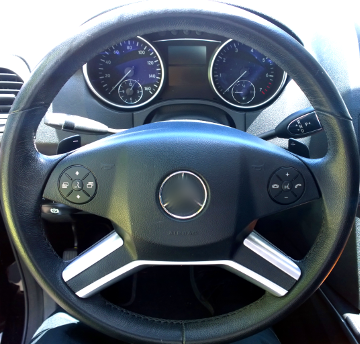I have loved gadgets every since I can remember. In the fourth grade, back before remote controls, I wired my TV and lights so I could turn them on from my bed. I also had speakers all over my room for that “surround sound” effect. It was my first introduction to gadgets and total living comfort. That was around the same time I fell in love with the automobiles, which were full of gadgets and mystery. Where else can you, from the “captain’s chair”, control so many devices? Think about what you control from the driver’s seat.
From the earliest days of the automobile, there always have been the basics such as steering, throttle position (gas pedal), brakes, clutch, emergency brake, and the gears for the transmission. As automobiles evolved, more devices were added, such as headlights, taillights, turn signals, horn, roll-up windows, windshield wipers, window washers and doors that open and close easily. Then came the creature comforts: heating, air conditioning, radio, rearview mirror and adjustable seat.

During the next evolution, even more luxurious gadgets and systems became commonplace: power windows and door locks, automatic climate control, power-heated outside rearview mirrors, remotes that start the car, open and lock the doors and trunk, incredible sound systems, power seats that move in most directions, heated and air conditioned seats, cruise control, controls on the steering wheel so you don’t even have to take you hands off the wheel to adjust cruise and the sound system, navigational GPS systems, back up cameras with collision warning sounds, two way communication and even interactive voice control navigational and phone systems, and driver-assistance systems such as OnStar.
Safety gadgets also have evolved with the addition of air bags and air curtains, seat belt tensioners that tighten in the first milliseconds of an accident, traction control that keep your wheels from spinning during acceleration, anti-skid controls to help your car regain control in a skid, and anti-lock brakes that help stop straighter and faster. Also being installed on more automobiles now are Xenon headlights, which project more light on the road. Some vehicles also have headlights that turn as you turn the steering wheel.
Some automobiles even have “smart” cruise controls that keep the same distance between you and the car in front of you and will start applying your brakes if the gap starts to close too quickly. Some vehicles have a “line detector” that will sound an alarm if you change lanes without using your turn signal or go over the “fog” line. It keeps tired people from unintentional lane changes. Other vehicles have a forward looking radar sensor that will actually put the brakes on if a crash is imminent. It also has the ability to close windows and sunroof and inflate chambers in the seats to position and cushion the occupants in the milliseconds before a crash. The modern automobile has an incredible amount of functional, luxury and safety features in it. Enjoy them for there is no other place on earth that has that many controls and comforts in such a small area. Oh, and the most important factor: the vehicles get you to where you need to go with incredible reliability, and for a long time. The average age of the vehicles on the road is at an all-time high, 11.4 years.
Check-engine challenge
The biggest challenge in the automotive repair and service department is the check engine light (service engine soon). Most folks think you hook up the diagnostic scanner and it tells us what is wrong. Actually this is incorrect, but it will give us an idea of where to start looking. A great example of this is a Jeep we got to work on. It was giving us codes for a device called the oxygen sensor. These devices are the “final check” to see if your vehicle’s exhaust is really clean. They even measure the pre-catalyst exhaust and post catalyst exhaust to see if the catalytic convertor is doing its job. Many problems will cause an oxygen sensor code when the oxygen sensor is doing its job. In this particular Jeep, an exhaust leak added extra oxygen to the exhaust gases, which caused the engine light to come on. Believe you me, these are very complicated systems.
40 years of changes
On May 1st, Euro-Asian Automotive celebrated 40 years in business. The evolution of vehicles over these past 40 years is incredible. What cars had then compared to what they have now is earthshaking. For example, air conditioning was rather rare back in 1975, and now it is main stream. Tune-ups were done every 5,000 miles and included points, condenser, distributor cap, rotor, spark plugs, air and fuel filter. When tuning a vehicle, it was a challenge to get the spark plugs with the correct voltage (up to 32,000 volts) firing at the correct time, with the correct air/fuel mixture. Many, many mechanical controls such as vacuum and centrifugal advances for ignition timing had to be checked, along with voltage potential, spark plug wires, carburetor air-fuel mixtures and many other checks and adjustments. Tuning was like conducting an orchestra, making sure every part is doing its job at the correct time. On modern vehicles, it’s all computer controlled. It just goes to show how the modern vehicle has evolved into a complex, dependable machine with many features to add to our driving enjoyment.